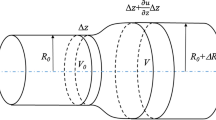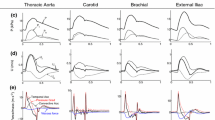Abstract
To predict the propagation of pressure and flow pulses in arterial system and the variation of vascular input impedance, a branched and tapered tube model is studied through one-dimensional transient flow analysis. Coupling the continuity and momentum equations yields a group of quasilinear hyperbolic partial differential equations which can be solved numerically by using the method of characteristics. Several boundary conditions of the arterial system are also simplified suitably.
The propagation of the pulses of the arterial system and the vascular input impedance is calculated on computer by using the dimensions and the physiological data of the arterial system. The results point out that the pressure and flow pulses of the arterial system and the vascular input impedance produced by this theoretical model is consistent quite well with the experimental results published.
Similar content being viewed by others
References
Anliker, M., et al., Prediction of shape changes of propagating flow and pressure pulses in human arteries,The Arterial System (1978), 15–34.
Lambert, J. W., On the nonlinearities of fluid flow in nonrigid tubes,J. Frank. Ins.,266, 2 (1958), 83–102.
Milnor, W. R.Hemodynamics (1982).
Murgo, J. P., Aortic input impedance in normal man: relationship to pressure wave forms,Circulation,62, 1 (1980), 105–116.
Nichols, W. W., et al., Input impedance of the systematic circulation in man,Circ. Res.,40, 5 (1977), 451–458.
Stettler, J. C., et al., Theoretical analysis of arterial hemodynamics including the influence of bifurcation,Annals of Biomedical Engineering, 9 (1981), 145–164.
Streeter, V. L., et al., Pulsatile pressure and flow through distensible vessels,Circ. Res.,13, 3 (1963), 3–20.
Westerhof, N., et al., Analog studies of the human systematic arterial tree,J. Biomech., 2 (1969), 121–143.
Wetterer, E. and Th. Kenner, Dynamik des Arterienpulses (1968).
Womersley, J. R., Oscillatory flow in arteries: the constrained elastic tube as a method of arterial flow and pulse transmission,Phys. Med. Biol., 2 (1957b), 178–187.
Author information
Authors and Affiliations
Additional information
Communicated by Wu Wang-yi
Rights and permissions
About this article
Cite this article
Zhao-rong, L., Yong-sheng, Z. A computer model of pulse wave and input impedance in human arteries. Appl Math Mech 9, 471–484 (1988). https://doi.org/10.1007/BF02465685
Received:
Issue Date:
DOI: https://doi.org/10.1007/BF02465685




